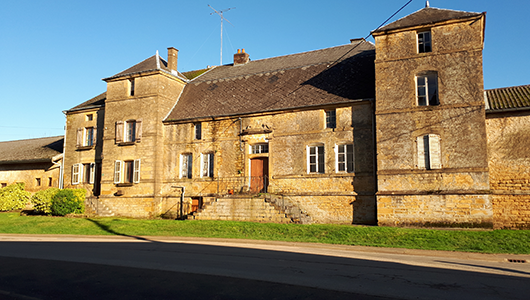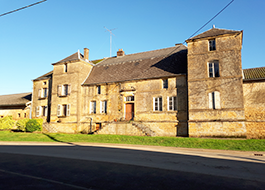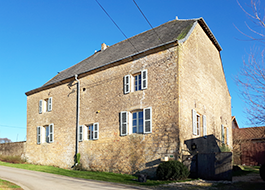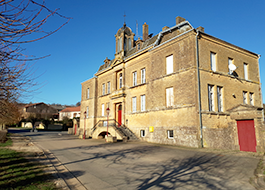Chauvency-Saint-Hubert
Durée visite : 35 minutes
Moyen : Pédestre
Le village s’est constitué à l’initiative de l’abbaye belge Saint-Hubert d’Andage au Xe siècle. Au XIIe siècle, on s’indigne, dans les chroniques, que l’avoué de l’abbaye fasse attacher des serfs à la charrue. Ces malheureux ne peuvent se plaindre à personne, car Chauvency est administrativement isolée au sein du comté de Chiny. Il n’y a pas de maison seigneuriale. Seuls quelques officiers de l’abbé y résident. En 1659, la France prend possession de la commune. La Révolution ayant supprimé le nom des saints en 1792, le village devient Chauvency-les-Forges jusqu’en 1814. La forge en question, installée sur le ruisseau du Bouillon, sert à l’artillerie.
The village was formed on the initiative of the Belgian abbey Saint-Hubert d’Andage in the 10th century. In the 12th century, we are indignant in the chronicles that the lawyer of the abbey had serfs attached to the plow. These unfortunate people cannot complain to anyone, because Chauvency is administratively isolated within Chiny County. There is no stately home. Only a few officers of the abbot live there. In 1659, France took possession of the town. The Revolution having suppressed the names of the saints in 1792, the village became Chauvency-les-Forges until 1814. The forge in question, installed on the Bouillon stream, was used for artillery.
Das Dorf wurde im 10. Jahrhundert auf Initiative der belgischen Abtei Saint-Hubert d’Andage gegründet. Im 12. Jahrhundert sind wir empört über die Chroniken, dass der Anwalt der Abtei Leibeigene am Pflug befestigt hatte. Diese unglücklichen Menschen können sich bei niemandem beschweren, da Chauvency in Chiny County administrativ isoliert ist. Es gibt kein stattliches Zuhause. Dort leben nur wenige Offiziere des Abtes. 1659 nahm Frankreich die Stadt in Besitz. Nachdem die Revolution 1792 die Namen der Heiligen unterdrückt hatte, wurde das Dorf bis 1814 zu Chauvency-les-Forges. Die fragliche Schmiede, die am Bouillon-Strom installiert war, wurde für Artillerie verwendet.

Parti : au 1er d’or au haut-fourneau flamboyant de gueules ; au 2e de gueules à la demi-ramure de cerf posée en pal.
Création Dominique LACORDE, Dominique LARCHER avec les conseils de la Commission Héraldique de l’UCGL et adopté par la commune le 11 décembre 2012.
Party: 1st in the blast furnace flamboyant Gules; 2nd Gules with the half-antlers of stag posed in pale.
Creation Dominique LACORDE, Dominique LARCHER with the advice of the Heraldic Commission of the UCGL and adopted by the municipality on December 11, 2012.
Party: bis zum 1. Gold mit dem lodernden Ofen von Gules; 2. Gules mit hellem Hirschgeweih.
Gründung Dominique LACORDE, Dominique LARCHER auf Anraten der Heraldischen Kommission der UCGL und am 11. Dezember 2012 von der Gemeinde verabschiedet.
Les points de visites
.
L’église saint-Hubert a été construite au XVIe siècle. La tour-porche a conservé une bretèche et quatre archères, traces de fortification. La bretèche est un petit avant-corps en encorbellement. Elle sert à lancer des projectiles sur l’assaillant. On est alors à l’époque des guerres de religion. La nef et le chœur ont été rajoutés en 1736. Sur l’angle gauche de la porte d’entrée se trouve un cadran solaire. Prés de l’église s’élève le monument aux enfants de la commune morts en 14-18.
The Saint-Hubert church was built in the 16th century. The tower-porch has preserved a bretèche and four archers, traces of fortification. The bretèche is a small cantilevered fore-body. It is used to launch projectiles at the assailant. We are then at the time of the wars of religion. The nave and the chancel were added in 1736. On the left corner of the entrance door is a sundial. Near the church stands the monument to the children of the town who died in 14-18.
Bretèche und vier Bogenschützen erhalten, Spuren der Befestigung. Die Bretèche ist ein kleiner freitragender Vorderkörper. Es wird verwendet, um Projektile auf den Angreifer abzufeuern. Wir sind dann in der Zeit der Religionskriege. Das Kirchenschiff und der Chor wurden 1736 hinzugefügt. In der linken Ecke der Eingangstür befindet sich eine Sonnenuhr. In der Nähe der Kirche steht das Denkmal für die Kinder der Stadt, die zwischen 14 und 18 Jahren starben.
.
.
Le prieuré de Chauvency-Saint-Hubert était autrefois rattaché à l’abbaye de Saint-Hubert. Le bâtiment couvert d’une toiture en ardoise est mansardé dans sa partie centrale. Deux tours carrées en saillie légères sont couronnées d’un toit en pavillon. De nombreuses ouvertures renforcent la légèreté de la façade. Le prieur représentait l’abbé de Saint-Hubert.
The priory of Chauvency-Saint-Hubert was formerly attached to the abbey of Saint-Hubert. The building covered with a slate roof has sloping ceilings in its central part. Two light projecting square towers are crowned with a pavilion roof. Numerous openings reinforce the lightness of the facade. The prior represented the Abbot of Saint-Hubert.
Das Priorat von Chauvency-Saint-Hubert war früher der Abtei von Saint-Hubert angegliedert. Das mit einem Schieferdach bedeckte Gebäude hat in seinem zentralen Teil schräge Decken. Zwei leicht vorspringende quadratische Türme sind mit einem Pavillondach gekrönt. Zahlreiche Öffnungen verstärken die Leichtigkeit der Fassade. Der Prior vertrat den Abt von Saint-Hubert.
.
Située 1, rue du Cimetière, la maison du prévôt est couverte d’une toiture en bâtière ardoisée. La date de construction, 1742, est inscrite en chiffre de fer forgé. Après l’annexion à la France en 1659, le village dépendait de la prévôté de Chauvency-le-Château. Sous l’Ancien Régime, le prévôt royal, est le premier degré de la justice royale. La prévôté adresse normalement tous les cas civils et criminels de son ressort, à l’exception des cas royaux, lèse-majesté, faux-monnayage, hérésie. qui relèvent des bailliages, et des cas concernant nobles et privilégiés. Elle reçoit l’appel des juridictions seigneuriales. On y fait appel au bailliage. Un lieutenant du prévôt résidait ici. Son supérieur se déplaçait aussi dans sa juridiction.
Located 1, rue du cimetière, the provost’s house is covered with a slate saddleback roof. The date of construction, 1742, is written in a wrought iron number. After annexation to France in 1659, the village depended on the provost of Chauvency-le-Château. Under the Ancien Régime, the royal provost was the first degree of royal justice. The provost normally addresses all civil and criminal cases within his jurisdiction, with the exception of royal cases, lese majesty, counterfeiting, heresy. which come under bailiwicks, and cases concerning noble and privileged. It receives the appeal of the seigniorial jurisdictions. They appeal to the bailiwick. A lieutenant of the provost resided here. His superior also moved within his jurisdiction.
Das Haus des Provost befindet sich in der Rue du Cimetière 1 und ist mit einem Schiefer-Satteldach bedeckt. Das Baudatum 1742 ist in einer schmiedeeisernen Nummer geschrieben. Nach der Annexion an Frankreich im Jahr 1659 war das Dorf vom Provost Chauvency-le-Château abhängig. Unter dem Ancien Régime war der königliche Provost der erste Grad königlicher Gerechtigkeit. Der Provost befasst sich normalerweise mit allen Zivil- und Strafsachen in seinem Zuständigkeitsbereich, mit Ausnahme von königlichen Fällen, Majestät, Fälschung und Häresie. die unter Vogteien fallen, und Fälle in Bezug auf Adlige und Privilegierte. Es erhält die Berufung der Seigniorial Jurisdiktionen. Sie appellieren an die Vogtei. Hier residierte ein Leutnant des Provost. Sein Vorgesetzter bewegte sich ebenfalls innerhalb seiner Gerichtsbarkeit.
.
Construite en 1867, la mairie-école prouve, par ses dimensions, l’importance de la population à l’époque, estimée à 605 personnes. De chaque côté se trouvent les écoles des filles et des garçons. La partie axiale de la façade tire son originalité de la superposition de deux portails. Celui du bas porte la date de construction en chiffres romains. La tour ressemble au clocher de l’église de Chauvency-le-Château. Elle possède des cadrans d’horloge sur ses quatre côtés.
Built in 1867, the town hall-school proves, by its dimensions, the importance of the population at the time, estimated at 605 people. On either side are the schools for girls and boys. The axial part of the facade derives its originality from the superposition of two portals. The lower one bears the date of construction in Roman numerals. The tower resembles the steeple of the church of Chauvency-le-Château. It has clock faces on all four sides.
Die 1867 erbaute Rathausschule beweist anhand ihrer Dimensionen die Bedeutung der damaligen Bevölkerung, die auf 605 Personen geschätzt wird. Auf beiden Seiten befinden sich die Schulen für Mädchen und Jungen. Der axiale Teil der Fassade leitet seine Originalität aus der Überlagerung zweier Portale ab. Das untere trägt das Datum des Aufbaus in römischen Ziffern. Der Turm ähnelt dem Kirchturm der Kirche von Chauvency-le-Château. Es hat Zifferblätter auf allen vier Seiten.









